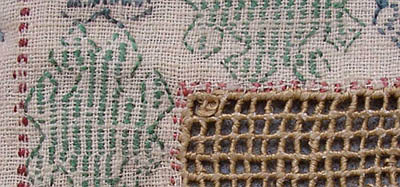Hi,
Here is the text description from the
Moscow museum's website:
Quote:
Village of Kalom-Khumb (?), Darvaz, Tajikistan. Second
half of the 19th century (before the 1870s)
Cotton, with
satin-stitch embroidery (pukhtaduzi) in silk.
75 × 65 cm.
Inv. No. 3098 III
Acquired in 1946 from a private collection.
First publication.
A ruband is a ritual veil which was worn
by brides who were supposed to cover their face during the wedding
feast and also while moving to their husband's house. During the
ruibenik (bride-show) the veil was slightly lifted for the girl's
in-laws to see her face.
The ruiband is a rare article which
has long ago become the exclusive property of museums. Rubands fell
out of use as early as the turn of the 20th century and were to be
found only in rich Tajik families where they were passed on as
family relics from mothers to daughters. The ritual function of the
ruiband determined its artistic symbolism. Its form, its colouring,
ornamental patterns and their arrangement were strictly
canonized.
This ruiband is the only example of this kind in
the collection of the Museum. It is an almost square veil of white
home-woven cotton fabric which has gone yellowish with age. A small
rectangular net for the eyes is made of white silk and framed with a
row of crimson stars-sitora. The central square consists of two
sections and has a wide border around it. The top section presents
an archaic motif of two heraldi-cally opposed stylized red
birds-peacocks or cocks-on either side of the Tree of Life. The
bottom section is decorated with large red stars-sitora. The border
is composed of three bands. The outer band is adorned with
alternating dark-blue, yellow and pale-blue triangles-the tumor
(amulet) pattern- and geometrically stylized two-headed birds
(tovus, or khurus). The overall pattern of this band is called "the
peacock (cock) and the amulet" (tovus va tumor). The ruband is
trimmed on the edge with a narrow tape of black silk.
The
presence of red, orange, crimson and blue accounted for the
traditional name given to the decor of ruibands-guli otash, or guli
alou (fiery flower). The red colour was associated by many peoples
(including the Tajiks) with powers of Good and was believed to be a
protection from evil, while birds were regarded as symbols of
fertility. |
Also, as described above for
the Moscow museum piece - possibly, an indicator of some degree of age, a
closeup of a ruband we own, showing the handspun groundcloth:

...and the
whole thing:

This is from the Russian
Museum of Ethnography website:
Quote:
| The ruband veil was a part of the wedding attire of the
highland Tadjik women of Kara-Tegin and Darvaz. It should cover the
bride's face from the moment of her transporting to her future
husband's home and during all the later ceremonies therein. The
first acquaintance of the bridegroom's relatives with the newly
married spouse took place during the rubinon ceremony (meaning
"looking at the bride's face"), when they came one by one raising
her veil, looking at her, and giving her presents. Covering of the
bride's face was linked with the ancient custom of avoidance, which
aim was to protect the girl from the evil eye and other malign
forces during the wedding, a moment of great importance for the
survival of her lineage. The bright, embroidered ornamentation of
veils also had protective functions. From times immemorial roosters,
abundant floral patterns, and red colors were associated with
natural energy and the life-giving power of the sun and fire. It was
believed that these decorative motifs averted a danger and brought
good luck, prosperity and childbearing. Rubands were made by
especially skilled embroiders and were rather high valued. A family
had usually only one ruband successfully used at weddings by several
generations of brides in this family as well as their neighbors. In
late 19th-early 20th centuries, they became rare because of
disappearance of home weaving and complexity of embroidery work, and
were only preserved as relics in some families. In wedding
ceremonies they were replaced by kerchiefs and shawls. |
...which is a description for this
mid-19th century ruband (a link, not uploaded.. HINT):

So, I think we can says
with some certainty that these pieces originate in the Darvaz region of
eastern Tajikistan.
Regards
Chuck Wagner